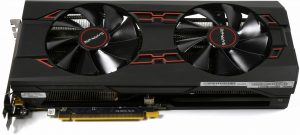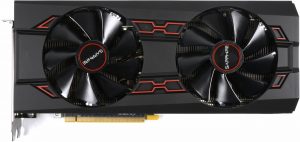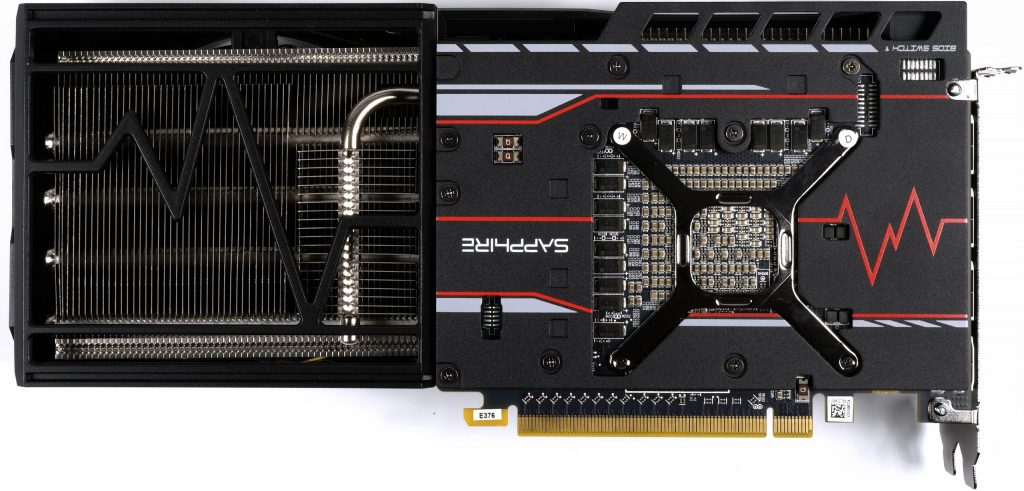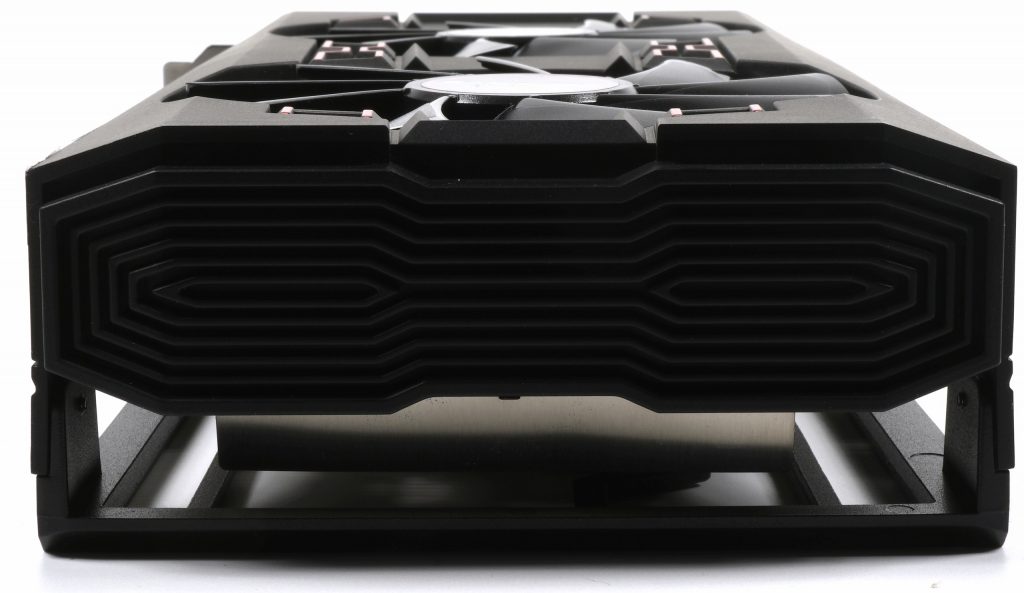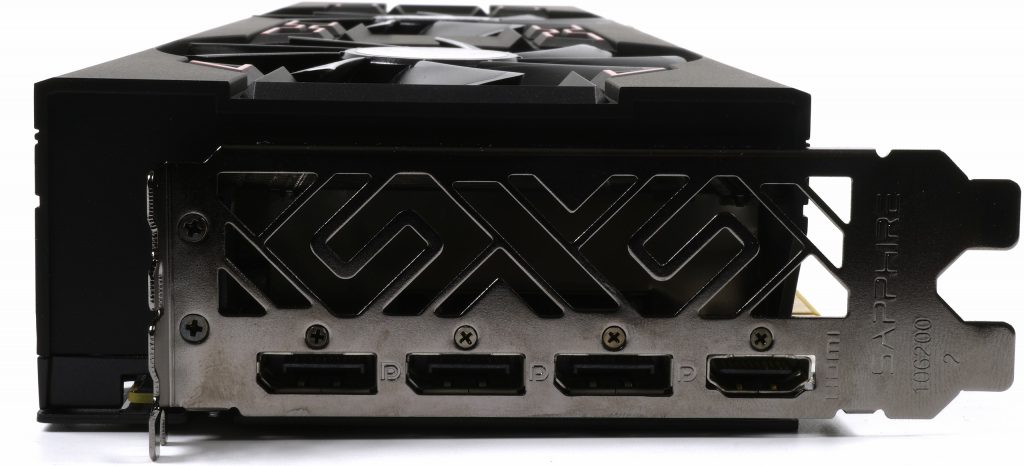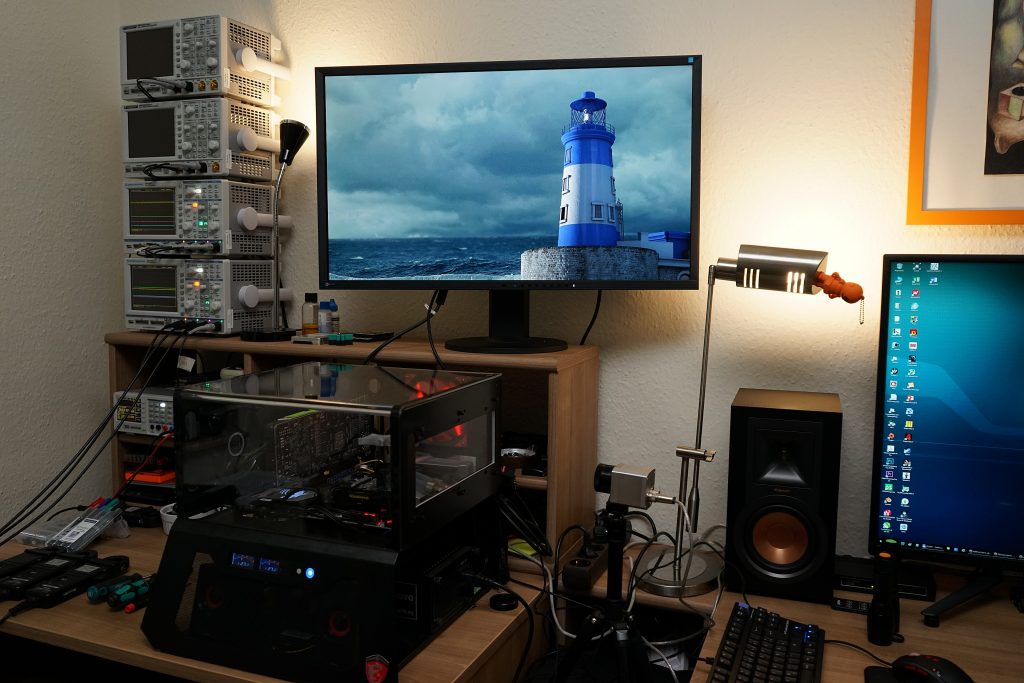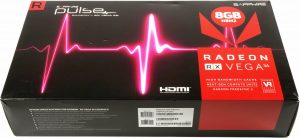 Like the Gigabyte RX Vega 56 Gaming OC , the Sapphire RX Vega 56 Pulse is more of a rational card, but equipped with completely different genes. Because in addition to the ultra-short board, we also find a very remarkable cooler here, which will be discussed later.
Like the Gigabyte RX Vega 56 Gaming OC , the Sapphire RX Vega 56 Pulse is more of a rational card, but equipped with completely different genes. Because in addition to the ultra-short board, we also find a very remarkable cooler here, which will be discussed later.
Vapor-Chamber? That is precisely what does not exist this time. But interestingly, it can also be done without it, if you only know how to help yourself cleverly enough.
We would also like to point out that we took the photos of the views with the first sample. However, this was dismantled, repaired, counter-tested and also sent back to Sapphire after our first IR measurements. All the benchmarks and new IR images come from the Retail replacement card. It should be noted that the repaired card from the pre-released practice test "Sneaky graphic flatfoot: When the RMA witch strikes behind and (k)one notices" and today's retail model delivered absolutely identical results. So that one can assume that the sample alone had a damage that no one had noticed before.
Unboxing, optics and haptics
Weighing just 938 grams, the Sapphire card is a significant 700 grams lighter than the in-house monstrous battleship RX Vega 64 Nitro. Even with the dimensions something would be starved and there are only 28.2 cm installation length (outer surface slot panel until the end of the radiator cover). With a height of 11.8 cm (from the top of the motherboard slot to the top of the radiator cover, as well as a thickness of 4.8 cm from the board to the front of the radiator cover, this results in the image of a beautifully compact map.
The two fans with a rotor blade diameter of 9.5 cm each sit in an opening with a diameter of 9.8 cm. With its special shape, a total of 9 rotor blades per fan mainly provide airflow and turbulence and less static pressure. This should be helpful to the cooling concept.
We see an ultra-short board that would also have honored an RX Vega 56 Nano and a full-length cooler. For cooling, such a board-free air system is of course an ideal case, as we will see later. After all, one should plan at least 5 mm for the rear body, which can already lead to problems with some motherboards if heat sinks are sitting too close to the slot or the CPU cooler is extremely large.
Also interesting is the second lamella heatsink with its own heatpipe, which sits separately between the board and the large heat sink. This part cools the stabilization frame and thus also the voltage converters. Smart idea, as you'll see later!
It is already clear from the bottom of the map that Sapphire, like so many in this performance class, relies on vertically executed slats. With this blast, this solution has hardly any disadvantages, on the contrary.
The top also clearly shows how short the board really is. The two external 8-pin power supply connections are located in front of the center of the card. You can't find an RGB ballfor kevin-Klaus's eye-wellness, on the other hand, and if I'm to be honest, I haven't really missed it. The DIP switch for the two BIOS variants sets at the usual location.
The closed end of the map shows nothing, but nothing at all. The closed radiator decoration even covers the ends of the four thick 8mm heatpipes. Chastened long skirt, no mini skirt with a free-up bacon roll.
The slot panel is very interesting in that it has only four instead of the five ports of the reference card. An HDMI 2.0 port and three displayport 1.4 are available to the user. The older DVI output has been completely dispensed with. Well, at some point it has to be over.
Finally, let us take a first look at the technical data. Sapphire offers a dual BIOS with 2-wire stages at the DIP switch and writes in the Specs itself:
Following AMD's guidelines for clock frequencies, however, the maximum turbo clock has been increased by 100 MHz, so that the displayed MHz number differs from the specs, for whatever reason.
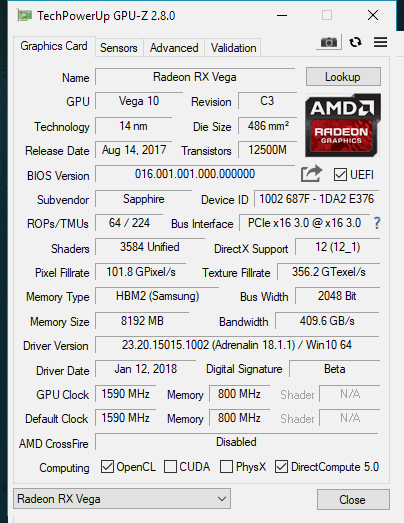
Compared to the relevant reference cards, this looks like this (we deliberately did not use the GeForce GTX 1070, as the overclocked RX Vega56 often acts much faster):
| Model | Radeon RX Vega64 Reference |
Sapphire RX Vega56 Pulse |
Radeon RX Vega56 Reference |
Geforce GTX 1070 Ti |
Geforce GTX 1080 Fe |
|---|---|---|---|---|---|
| Gpu | Vega 10 | Vega 10 | Vega 10 | GP104 | GP104 |
| Chip size | 484 mm2 | 484 mm2 | 484 mm2 | 314 mm2 | 314 mm2 |
| Transistors | 12.5 billion | 12.5 billion | 12.5 billion | 7.2 billion | 7.2 billion |
| GPU base clock/ Boost clock |
1274 MHz 1546 MHz |
1275 MHz 1590 MHz |
1156 MHz 1471 MHz |
1607 MHz 1683 MHz |
1607 MHz 1733 MHz |
| Shader/SIMD | 4096/64 | 3585/56 | 3585/56 | 2432/19 | 2560/20 |
| Texture Units/ Rops |
256 64 |
224 64 |
224 64 |
152 64 |
160 64 |
| Pixel fill rate |
99 GPix/s | 102 GPix/s | 94 GPix/s | 108 GPix/s | 114 GPix/s |
| Texture Fill Rate | 396 GTex/s | 356 GTex/s | 330 GTex/s | 244 GTex/s | 257 GTex/s |
| Memory connection | 2048 Bit | 2048 Bit | 2048 Bit | 256 bits | 256 bits |
| Storage type | HBM2 | HBM2 | HBM2 | GDDR5 | GDDR5X |
| Memory bandwidth |
484 GB/s | 410 GB/s | 410 GB/s | 256 GB/s | 320 GB/s |
| Memory clock |
1.9 Gbps | 1.6 Gbps | 1.6 Gbps | 8 Gbps | 10 Gbps |
| Storage expansion |
8 GB | 8 GB | 8 GB | 8 GB | 8 GB |
| DX Feature Level | 12_1 | 12_1 | 12_1 | 12_1 | 12_1 |
| PCIe sockets | 2 x 8-pin | 2x 8 Pin | 2 x 8-pin | 1x 8-pin | 1x 8-pin |
| Tbp | 295 watts | 265 watts | 210 watts | 180 watts | 180 watts |
Test system and measurement methods
The new test system and the methodology have already been described in great detail in the basic article "How We Test Graphics Cards" (English: "How We Test Graphics Cards") and therefore, for the sake of simplicity, we now only refer to this detailed Description. So if you want to read everything again, you are welcome to do so. However, we have again improved CPU and cooling to largely exclude possible CPU bottlenecks for this fast card.
If you are interested, the summary in table form quickly provides a brief overview:
| Test systems and measuring rooms | |
|---|---|
| Hardware: |
Intel Core i7-6900K -4.3GHz MSI X99S XPower Gaming Titanium G.Skill TridentZ DDR4 3600 1x 1 TByte Toshiba OCZ RD400 (M.2, System SSD) 2x 960 GByte Toshiba OCZ TR150 (Storage, Images) Be Quiet Dark Power Pro 11, 850-watt power supply |
| Cooling: |
Alphacool Ice Block XPX 5x Be Quiet! Silent Wings 3 PWM (Closed Case Simulation) Thermal Grizzly Kryonaut (for cooler change) |
| Housing: |
Lian Li PC-T70 with expansion kit and modifications Modes: Open Benchtable, Closed Case |
| Monitor: | Eizo EV3237-BK |
| Power consumption: |
non-contact DC measurement on the PCIe slot (Riser-Card) non-contact DC measurement on the external PCIe power supply Direct voltage measurement on the respective feeders and on the power supply 2x Rohde & Schwarz HMO 3054, 500 MHz multi-channel oscillograph with memory function 4x Rohde & Schwarz HZO50, current togor adapter (1 mA to 30 A, 100 KHz, DC) 4x Rohde & Schwarz HZ355, touch divider (10:1, 500 MHz) 1x Rohde & Schwarz HMC 8012, digital multimeter with storage function |
| Thermography: |
Optris PI640, infrared camera PI Connect evaluation software with profiles |
| Acoustics: |
NTI Audio M2211 (with calibration file) Steinberg UR12 (with phantom power for the microphones) Creative X7, Smaart v.7 own low-reflection measuring room, 3.5 x 1.8 x 2.2 m (LxTxH) Axial measurements, perpendicular to the center of the sound source(s), measuring distance 50 cm Noise in dBA (Slow) as RTA measurement Frequency spectrum as a graph |
| Operating system | Windows 10 Pro (Creators Update, all updates) Radeon Software Adrenaline (17.12.2, status December 2017) |














